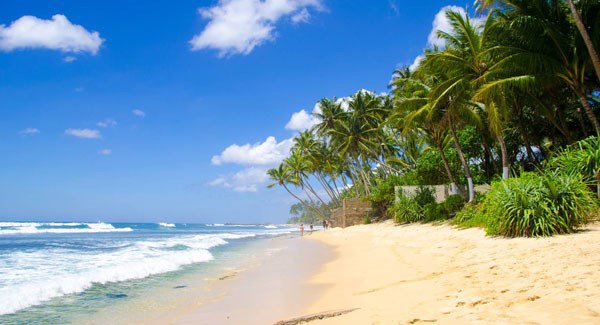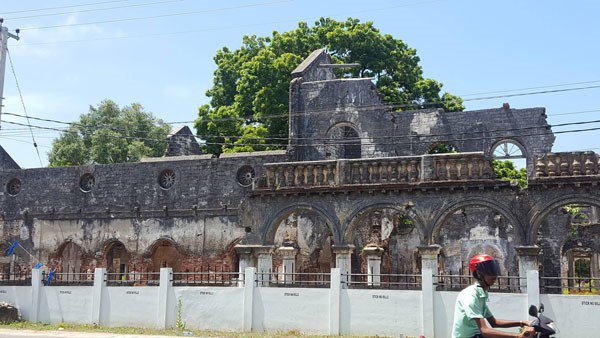As the north of Sri Lanka recovers after nearly 30 years of civil war, Shilpa Ganatra visits the former no-go zone of Jaffna and finds an intriguing city yet to be touched by tourism.

THREE things one might envision when discussing Sri Lanka: tea, urban singer M.I.A, and the Tamil Tigers. Not the most natural of triptychs, but it does speak of the many sides of the tiny island, located metres away from the tip of India.
Its modern history is defined by the unusual terms of its civil war: the attempt of the Liberation Tigers of Tamil Eelam (LTTE) for a separate state lasted from 1983 to 2009, yet the country remained surprisingly open to tourists as the fighting was contained to the north and east of the country, allowing the beauty of the south and west to be appreciated by honeymooners, adventurers and nature lovers.
Seven years on from the end of the war, and the times, they are finally a-changing.
In 2015 tourist permits for entry to the north were abolished, allowing freedom of movement throughout the country.
Consequently, last year, the domestic high-end hotel chain Jetwing were the first comfort hotel (read: one with a rooftop bar) to open in the former rebel heartland of Jaffna, signifying that the last of the no-go zones was open for business.
So eschewing the well-trodden safari parks and honeymoon-heavy beaches the country is known for, my travel companion and I trundled up the A9, a major road linking the north to the rest of the country, which was always partly or fully off-limits during the war until it was finally demined and restored.
A drive-by view of the environs suggested that a shadow of the war remains. Between small shops — never larger than a corner shop, though double-level for clothes stores — the scars of the war remained: bullet-pocked houses lay abandoned, some had their roofs blown off.
It added an eerie air to the journey, compounded at Kilinochchi.

An hour south of Jaffna, it was the de facto home of the of the rebels’ headquarters, and its capture by government forces after three months of intense fighting pinpointed the beginning of the end.
Given the extensive damage to the area, it’s evidently been restored where possible.
But one stark reminder of its history remains — the fallen water tower. Blown up by the LTTE in January 2009, a board by the gargantuan structure explains why it’s left slain at the side of the A9, bullet-holed and broken: “This fallen tower was once the source of water — the fountain of life — for the people of Kilinochchi… This is a monument to the futility of terror — and to the resilience of the human spirit.”
Indeed, while the sheer size of the tower meant its deathly image followed me around for the rest of the trip, it was clear Sri Lanka’s story has a happy ending.
I was sure of it, because no sooner did we enter Jaffna’s catchment area, then we were stuck in traffic. Loads of it. So I knew they were prospering up there.
Exhilarating isn’t the word to describe Jaffna. A coastal city (it has a cathedral) which survived the war, there’s an extra vibrancy to life within it which ignores the heavy military presence and the war-torn buildings.
In contrast to everything between Colombo and Jaffna, it pulses with atmosphere, markets, major stores and commerce — it even has a KFC, the only western shop I spied throughout the holiday.
It’s an oddity which a little makes more sense given it was the second largest city in pre-war times, and it’s currently returning to its former glory.
The narrow crumbled pathways of the centre, enclosed within AB roads, is busier than in Colombo, and the footfall means that trade is rife too.
The old market, however, remains quiet, which is a surprise as it holds some of the cheapest saris we’ve seen (even in India) and a range of pottery that makes for useful presents.
But that’s not what struck me most when wandering about; what was evident was that tourists were still a rare find here.
Of Indian descent, I blended in a little better than my Galwegian friend, who attracted grins and gentle calls from every passing shop owner.
Stopping into the shoe chain store elsewhere, a customer service assistant paused his assisting to tell us about his brother in the UK, a story echoed by another new friend we met in a hidden sari shop.
Both suggested that emigration broke up families, but the money sent home kept the city afloat when the industries couldn’t.
While the money is returning, tourists haven’t quite.
At night, keen to see what the nightlife has to offer, we wore our best gladrags and ventured out, only to find that the swarms of cars and people had dissipated, like any Irish city on Christmas Day.
A walk around confirmed that it’s a place that shuts up shop at night: wild dogs in packs and roaming cows outnumber the people on the street. It was just us — walking fast at this point.
Guidebooks suggested there are a couple of tourist bars and a few other hotel restaurants, but local life consists of dinner parties of friends fuelled by arrack, a coconut equivalent of poitin.
Dinner in such a situation is rice and curry: an array of about 70 curries with differing spice-levels, served with the most flavoursome dhal around, coconut sambal and plain white rice.
Trying this back at the hotel restaurant, with an arrack cocktail for added westernisation, was a feast for the eyes as much as the stomach.
Intriguing curries, like winged beans, gourd and jackfruit made this thali distinctly Sri Lankan, if the heavy spices and abundance of coconut-related products didn’t already.
By day, cafes (also confusing called hotels) are plentiful, some empty, some heaving.
Following the travellers’ number one rule of going to the busy places, we fell upon Sri Nigetha Bhavan Restaurant, a no-frills vegetarian place where the dozen dishes served are on display in the shop window.
With our tourist status, we were shown in like royalty and given a table in a separate room, before we insisted that actually, we’d prefer to eat with everyone else.
We almost wish we hadn’t — like getting on a bus in a foreign city, you always make a fool of yourself the first time.
After the food came — a giant portion of vegetable kottu (like a Pad Thai with shredded cabbage instead of noodles), vadai (a floury type of bhaji) and pittu (flour and coconut rolls), all served on a large banana leaf to be eaten with hands — the helpful waiter brought us a jug of accompanying vegetable curry and hovered around us, presumably to ensure the food was up to our standards.
Only when the need finally became greater than his manners did he ask to take the curry jug away with a pained face — it was meant for all the customers, not just our table.
As we were practically curtseyed out of the restaurant having paid just 450 rupees (a competitive €2.80) for the meal, it was evident that we must have been the first international tourists in their doors for a while, if not ever, which seemed out of place with such an urbanised city. But that’s set to change.
With a number of sightseeing spots, like the tranquil temple island of Nainativu Island, the beautiful new public library (to replace the war-torn old one) and its imposing fort to add to mass market appeal, it won’t take long before it’s added to the tourist trail.
My advice? See it before that happens.
How to get there
Flights
Indirect flights from Cork, Shannon, Dublin Knock and Kerry cost from €570 from Ireland with Aer Lingus and Sri Lankan Airlines.
If you’re feeling flush and lucky, Sri Lankan Airlines www.srilankan.com auction off their empty business class seats between London and Colombo for a minimum US$750 bid, meaning flat beds, a better entertainment system and a gourmet menu including champagne for less than half price.
Tour operators The Earth Trip www.theearthtrip.co.uk cover ground arrangements from Colombo.
Accommodation
Jetwing Jaffna www.jetwinghotels.com is the only mid-to-high range hotel in the area; rooms cost around €120 for a double.
For a budget option, try Green Grass Hotel www.jaffnagreengrass.com €30 a night.
What to see
The sights: Nainativu Island is the biggest draw to Jaffna for domestic tourists – it hosts two temples, though there are plenty of other temples and islands to explore too.
Jaffna Fort by the seafront promenade is deserved of a walk, while the New Library is a beautiful building of knowledge. Also visit Keerimalai hot springs, which are said to have healing powers.
The shopping: Jaffna’s New Market on Hospital Road is a wealth of clothes stores, bargain saris and jewellery. Nearer the bus station, stalls sell tea, pottery and toys. To buy some famous Sri Lankan spices or coconut-related products, try Cargills, the main supermarket.
The food
Jetwing’s hotel restaurant does an excellent dinner, and its rooftop bar has the largest selection of drinks you’re likely to find in Jaffna, a city which rarely gives out liquor licenses.
Also try the vegetarian restaurant Sri Nigetha Bhavan Restaurant on Power House Road. For a sweet treat, head to Lingan Cream House on Stanly Road.
Source : Irish Examiner